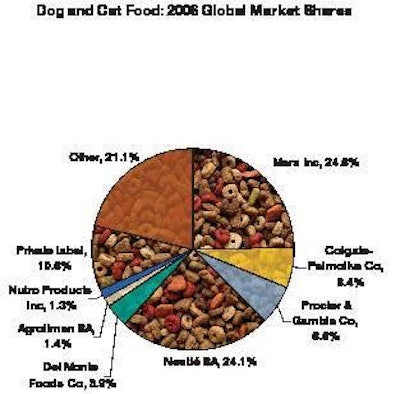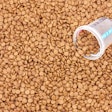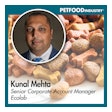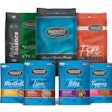
Although private label products occupy a prominent position in the dog and cat food marketplace, Euromonitor International data shows that their overall global market value share fell slightly from 10.8% to 10.6% between 2003 and 2006. However, beneath this headline decline a more complex picture of regional and category trends emerges, and, taken together, these trends suggest that private label dog and cat food will pose a renewed threat to branded products in the medium term.
Premiumization hurts private label
The main factor behind the decline in the relative importance of private label dog and cat foods in developed economies has been the premiumization of the market. The value share of dog and cat food sales accounted for by premium brands globally has jumped 10%, to 43.7%, in the 10 years to 2007, while that of economy brands fell from 18.9% to 16%. Meanwhile, the mid-price segment fell by 7% during this period, to 40.3% of total dog and cat food sales by value.
Globally, Euromonitor data shows that private label products accounted for 42.2% of economy dog and cat food value sales in 2006, compared with just 3.9% in the premium category. Clearly, this shift toward premium petfood is depressing the growth of private labels. Increasingly aware of the impact that this trend is having on their bottom lines, private label petfood manufacturers are attempting to increase their presence in the premium segment, with Euromonitor data showing that their share of value sales in this segment rose 1.2% during the period 2000-06.
Private label more accepted in Western Europe
There is a significant difference between North America and Western Europe (the only two regional markets in which there is a significant private label presence in the premium segment). Private labels accounted for 6.9% of premium dog and cat food value sales in Western Europe during 2006 (up from 6.6% in 2000), compared with just 3% in North America (albeit up from 0.9% in 2000).
Western European consumers appear to be more price sensitive than their North American counterparts: This is reflected in Euromonitor data showing that annual expenditure per pet in the US rose from US$45.20 to US$63.10 between 1998 and 2007, while in Germany, spending grew by just US$0.40, to US$47.40, over the same period.
Crucial role of pet superstores
Private label petfood manufacturers are appealing to potential customers in the premium segment by tapping into the same trends as their branded counterparts, using better quality or organic ingredients and incorporating functional properties into their offerings in order to appeal to the anthropomorphic instincts of pet owners, as well as targeting specific life stages. However, premium private label products still represent something of a counterintuitive proposition for consumers, many of whom remain skeptical that private labels represent an effective substitute for branded goods in the premium segments. It may take some time for this perception to be overcome.
Pet superstores could play an important role in bridging this gap, as some of the more prominent among them may have built up enough equity in their retail brands to convince consumers that they can offer them greater value than traditional branded products without sacrificing quality. Although Wal-Mart and Target launched their own premium petfood products (Natural Life and LIFELong, respectively) during 2006, it is unlikely that such non-specialist retailers as hypermarkets and supermarkets will be able to replicate this type of relationship.
German market a harbinger?
This trend is already visible in Germany, where Euromonitor data shows that pet superstores accounted for 28.6% of overall value sales in the petfood and pet care market in 2007 and private labels accounted for 35.7% of premium dog and cat food sales in 2006. In the US (where pet superstores have grown their share of petfood sales from 19.9% to 22.1% between 1998 and 2007), the likes of PetSmart and Petco are also well positioned to emulate this success.
Developing economies
In the developing world, private labels have only a marginal presence in the mid-price dog and cat food segment and none at all in the premium segment. However, they do have a notable presence in the economy segment, accounting for 16.2%, 8.2% and 10.1% of value sales in Eastern Europe, Latin America and Asia Pacific, respectively, according to Euromonitor data. In these regions, volume growth arising from a combination of rising rates of retail penetration and a reduction in poverty rates are the most important drivers of increased petfood sales.
In China, for example, local pet superstore chain Cool Baby is beginning to shift its expansion strategy away from Shanghai and Beijing and toward such second-tier cities as Nanjing and Yantai. Similar trends are also evident in India, provincial Russia and northern Brazil. This growth will provide excellent opportunities for private label manufacturers to increase their market share, particularly as many of these new consumers will be extremely price sensitive.
Recalls intensify instability
To a degree, the manner in which these developments are played out in the longer term, particularly in North America, will be influenced by the recalls of spring 2007. On the one hand, it could prompt a flight to quality as consumers seek the reassurance of quality they believe branded products provide. On the other hand, the fact that both branded and private label products have been affected by the recall may, to an extent, lift the veil from the eyes of consumers regarding the true extent of the quality differential between branded and private label petfood products. This could boost private label sales if it makes consumers more skeptical regarding the advantages of branded petfood.
The interplay of these conflicting reactions to the recalls will be complex, and branded petfood manufacturers will have to increase their marketing budgets to protect their market shares, as well as paying increased attention to their raw material sourcing, as traceability is likely to command a premium. The most likely outcome of the recall is that it will provide a window of opportunity for private labels to exploit.
.jpg?auto=format%2Ccompress&crop=faces&fit=crop&h=48&q=70&w=48)


.jpg?auto=format%2Ccompress&fit=crop&h=167&q=70&w=250)















